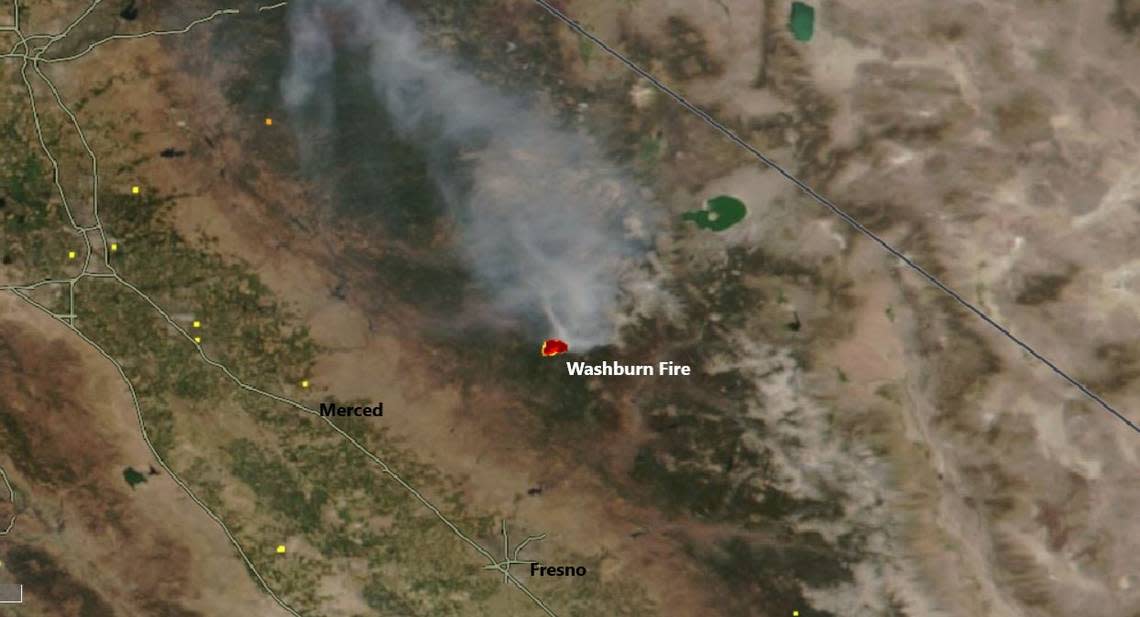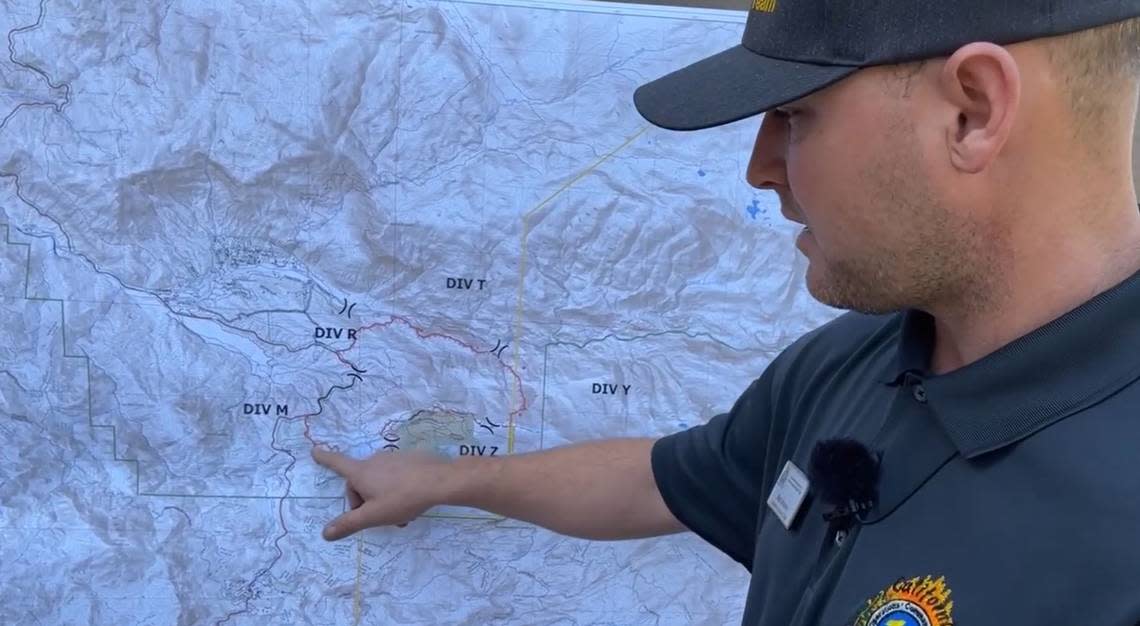Yosemite wildfire updates: Firefighting force grows; Wawona, Mariposa Grove remain threatened
The wildfire inside Yosemite National Park that threatens the community of Wawona and the Mariposa Grove of giant sequoias continued to grow overnight, expanding to more than 2,300 acres by Monday morning.
But fire crews reported gaining some success in establishing containment lines around some parts of the fire, including near Mariposa Grove. As of midday Monday, the fire was reported at 25% contained.
The Washburn Fire began Thursday afternoon near the Washburn Trail in the Mariposa Grove, near the southern entrance to the park.
From the outset, park officials launched what they called a “full suppression” response against the blaze, attacking with firefighters not only from the National Park Service but also calling upon other state and local resources.
What was reported as a 46-acre fire on Thursday night has grown steadily, to 466 acres by Friday evening, about 1,100 acres Saturday night, and more than 2,000 acres by Sunday night.
The National Interagency Fire Center reported Monday morning that the latest estimate for the Washburn Fire is 2,340 acres, continuing to burn in areas of timber and brush marked by rough terrain and an abundance of dead trees.
Marc Peebles, a fire information officer with the state incident command team, said Monday’s priority for firefighters was ongoing efforts to protect the giant sequoias in Mariposa Grove, the Wawona community and other park infrastructure in the area.
As the fire has grown, so too has the number of resources being put up against it. As of Monday morning, almost 550 people were engaged in the firefight, including 15 hand crews, 31 engine crews and 12 helicopters. That’s an increase of more than 180 firefighters compared to Sunday morning. The estimated cost of battling the fire has climbed to $2.1 million, according to the national fire center.
Those efforts are starting to pay off, fire officials said Monday morning.
“We are starting to show some containment and we’re going to start increasing containment in our fire updates,” said Matt Ahearn, deputy operations chief with the California Interagency Incident Management Team that is coordinating the firefighting effort, in a briefing shortly after 9:30 a.m.
One area that is considered contained is along the southwestern flank of the fire with a hand line near the Mariposa Grove Road, Ahearn said.
“Around Mariposa Grove Road to Highway 41 (Wawona Road), they’re working on bringing fire down, backing fire, tactical fire, and they have fired down to the corner of Highway 31 and Mariposa Grove Road,” Ahearn added.
“The objective for today is to continue to close this off around 41 to the fire’s perimeter. … We’re looking at holding and securing Highway 41.”
Using fire to fight fire
In a social media post, Ahearn explained that in addition to crews cutting hand lines and bulldozers clearing firebreaks, setting backfires or “offensive firing” is among the tactics that firefighters can use to gain the upper hand over a wildfire.
In Yosemite, backfiring is being used to ensure that the Washburn Fire does not cross to the west of Wawona Road.
“Offensive firing is one of those options that gets (the fire) down to a pre-established control line,” Ahearn said. “The crews go up to the actual controlled fire’s edge and they’ll start working off that uncontrolled edge bringing fire down the slope.”
“Backfiring along the highway allows us to introduce low-intensity fire, bring it down the slopes to the control system, the road,” he added. “It gets the fire down to our control line (to) get in there, secure it, mop it up, extinguish it, remove the hazard trees and be done much quicker.”
Firefighting danger
The firefight has also involved air tanker planes dropping fire-retardant chemicals – operations that can be effective, but also come with a level of risk.
On Saturday, the pilot of a lead plane operated by the U.S. Forest Service radioed to his base that a branch came up over his aircraft and fell earthward behind it and in front of the air tanker following behind him. Some online reports referred to it as a “close call,” but the general manager of the company that owns the tanker said that was apparently exaggerated.
“I talked to our captain and co-pilot in that (tanker) aircraft, and they said it was a pretty textbook drop coming about 150 feet off a ridgeline,” Matt Isley, general manager for Oregon-based Aero Air, told The Fresno Bee on Monday. “They were about one-third to a half-mile behind the lead plane, and they said they didn’t see the branch.”
“A close call would have been if they saw the branch,” Isley added.
The aircraft, an Erickson Aero Air Tanker 103, is a McDonnell-Douglas MD-87 twin-engine jet built in 1991, according to Federal Aviation Administration records.
Isley said the tanker crew, operating from a firefighting attack base at the former McClellan Air Force Base near Sacramento, didn’t learn about the lead plane’s report until after the flight.
The branch was most likely a piece of forest debris blown up into the air by powerful updrafts created by the wildfire before falling back to earth, Isley said. “In every mission, there’s inherent danger,” he said. “Basically they’re flying an airliner about 150 feet off the ground.”
Isley described actual debris strikes on aircraft “fairly rare.”
The conditions for flying to drop chemicals on a fire include not only smoke, but challenging winds. “These guys do a tremendous amount of planning for their drops, looking at what the winds are doing and the smoke conditions,” Isley added.
The tanker made one more trip to reload with chemicals and made one more drop run a rising smoke column created issues for visibility, liming any additional flights, Isley said.
A day earlier, a different tanker aircraft operated by another company was struck by debris while making a drop on the Washburn Fire, Isley said. But that tanker apparently sustained no damage and was back up in the air and flying more missions later in the day.
Smoke effects in the mountains
The southern entrance to Yosemite National Park is closed, and the southern end of the park around Mariposa Grove and Wawona are also closed to visitors.
Park rangers said that the rest of the park remains open and accessible via Highway 120 and Highway 140. But they advise that smoke from the Washburn fire is creating smoky conditions and potentially unhealthy air quality in parts of the park.
The smoke, however, doesn’t respect park boundaries.
On Sunday, smoke from the fire prompted the operators of the Yosemite Mountain and Sugar Pine Railroad, a popular and historic tourist attraction in Fish Camp south of the park boundary, to close until air quality conditions improve.
Overnight Sunday, an air quality monitor at the railroad showed an index as high as 610 for tiny particulate matter, on a scale for which an index at or above 300 represents the trigger for health warning of emergency conditions.
By Monday afternoon, the level was down to 112, a level at which people in sensitive groups may experience health effects with 24 hours of exposure, but at which the general public is less likely to be affected.


